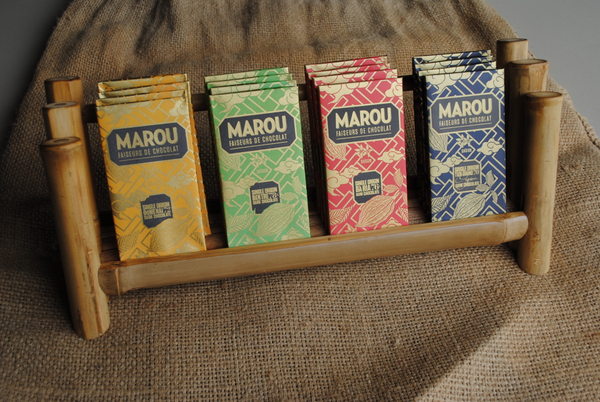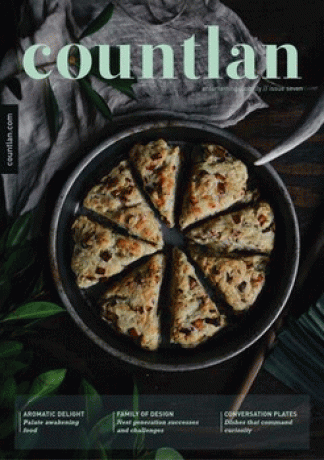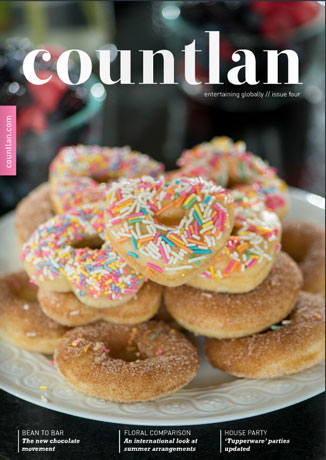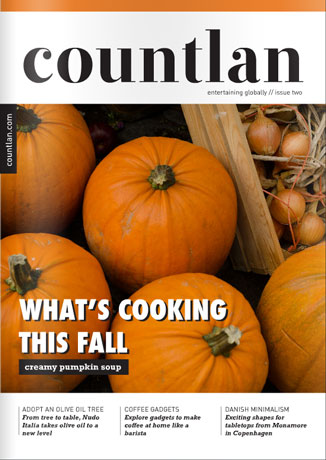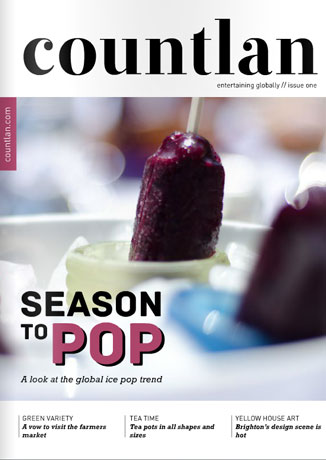
Bean to Bar: At the Source Marou Chocolate
When Samuel Maruta and Vincent Mourou started MAROU chocolate two years ago, it was on a hunch that there was something to be done with cacao from Vietnam. Both Samuel and Vincent, who are French with a multi-cultural background (Samuel grew up in France and is half-Japanese, while Vincent grew up and lived most of his life in the US), associate fine chocolate with childhood memories in France. “I guess we were spoilt! We turned this love of chocolate into a business. We saw an opportunity to do something with cacao in Vietnam at a time when it was not recognized at all” says Samuel.
Based in Saigon (Ho Chi Minh City), Vietnam, MAROU exclusively sources beans from a dozen small Vietnamese producers, more specifically those located in southern Vietnam in areas such as Tien Giang and Ben Tre provinces in the Mekong Delta, Ba Ria on the coast and Dong Nai and Lam Dong towards the highlands. “We know cacao production is surging further north in the highlands of Daklak but we tend to buy within a short range of provinces that we can visit on a day trip. We test every bag of beans we buy at the farm and we like to keep a close relationship with our providers.”
INTERVIEW: Samuel Maruta, Co-Founder Marou Chocolate Vietnam (Countlan Magazine Issue 04)
01 Who are you?
We are Samuel Maruta and Vincent Mourou, MAROU is our brand name and a contraction of out two family names. We’re both French, both with a multi-cultural background (Vincent grew up and lived most of his life in the US, Samuel grew up in France but is half-Japanese), and we started MAROU two years ago on a hunch that there was something to be done with cacao from Vietnam.
02 Where are you based?
We are based in Saigon, aka Ho Chi Minh City, the largest city in Vietnam.
03 What type of beans do you use in the creation of your chocolates?
We use exclusively beans sourced from small Vietnamese producers, currently we work with around a dozen producers including three or four members of the same co-op in the Mekong Delta.
04 Why was becoming a bean to bar producer important to you?
We totally identified with the backlash against industrial chocolate and we thought that being in a country that produces cacao we had a unique opportunity to add value to the local farmers’ production by bringing it to the world in a form that we could be proud of.
05 What is the origin of the beans you use?
Vietnam only, more specifically southern Vietnam: Tien Giang and Ben Tre provinces in the Mekong Delta, Ba Ria on the coast and Dong Nai and Lam Dong towards the highlands. we know that cacao production is surging further north in the highlands of Daklak but we tend to buy within the short range of provinces that we can visit on a day trip, because we test every bag of beans that we buy at the farm and we like to keep a close relationship with our providers.
06 What type of chocolate is Marou Chocolate known for?
We are dark chocolate fundamentalists! None of our bars are flavoured or made with milk. We also don’t believe in soy lecithin or vanilla, but that is hardly radical for bean-to-bar makers! On the other hand we are quite old-school about roasting (we don’t do raw), particle size (fine) and cocoa butter (we like to add some for extra smoothness). In a sense we’re only just following the example of the house of Bonnat who has been making chocolate this way in the French alps since 1884!
07 How did you get into the chocolate business?
Both of us associate fine chocolate with our childhood memories in France, I guess we were spoilt! We turned this love of chocolate into a business because we saw the opportunity to do something with cacao in Vietnam at a time when it was really not recognized at all and because for personal reasons we were ready to take chances. Had we not been there at that time, I very much doubt that we’d be making chocolate now.
08 Do you think bean to bar is another fancy marketing term or something customers should pay attention to?
Bean-to-bar is not a marketing term, it’s a movement, a swing of the pendulum, just like slow-food or micro-breweries, so now is a very exciting moment to be creating a new chocolate brand. Having said that I think that in a few years time, when the dust has settled, many small bean-to-bar companies will have disappeared, but the rest will have broken a path into a fantastic new landscape where fine chocolate will be more like wine today, with a more discerning public and a greater appreciation for where it comes from and the art with which it is made. These are totally exciting times.
09 Do you entertain at home?
Oh yes, tropical bohemian is the name of the game. I live in a large decrepit house by the Saigon river, with mangrove swamps brushing against the terrace; we have a bunch of very entertaining friends, nights are extremely hot and the house is not air-conditioned, so when we have friends over, after a few rounds of drinks the parties tend to turn into a mix of Blake Edward’s The Party and the closing scenes of Apocalypse Now!
10 How do you like to eat chocolate?
On its own, or with some bread and salted butter. For those who don’t believe in salt with chocolate, it’s an interesting way to come around the idea of chocolate with salt.
11 What is your favourite type of chocolate?
Dark, full of flavour, complex but pleasant.
12 When you have guests over, is chocolate always on offer to guests?
The thing is if we don’t bring the chocolate, our guests will demand it! On its own or baked into a cake. A personal favourite is the very moist chocolate cake recipe from Alice Waters’s The Art of Simple Food.
13 What’s next for you guys?
First survival. Then growing big (or loud) enough to make a difference where it matters (for us it’s about putting cacaco production in Vietnam on the path to quality-over-quantity and that means continuing to be happy with the way the cacao we use to make our chocolate is grown and its impact on the environment and farmers’ livelihoods).

Photo Source: Marou Chocolate
Web: marouchocolate.com






